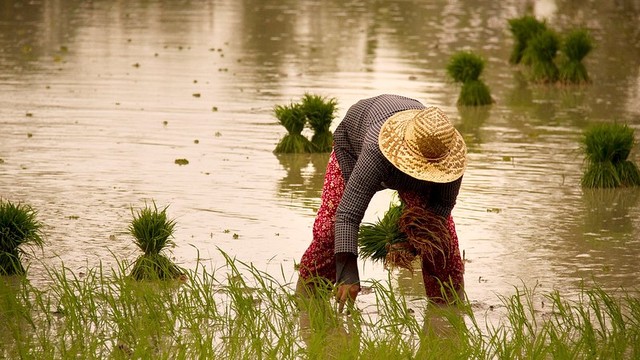Sustainable agriculture in China: then and now
The environmental impacts of China's agricultural production affect not just China, but also the global environment. An IIED and China Agricultural University workshop explored examples and models that could help promote sustainable agricultural practices in China.


A farmer in a buckwheat field close to harvest time in Gansu Province, China. The country's agriculture is currently facing major environmental challenges (Photo: Copyright Han Jianping)
It's well known that China is the largest producer and consumer of many crops today. But China's agriculture also has global impacts. Even as it imports more and more grain, soybeans and other agricultural commodities, China is also a major exporter of both fresh produce and processed foods.
Changes in food production and consumption in China and their environmental effects both domestically and internationally therefore concern us all. With these issues in mind, IIED and China Agricultural University (CAU) co-hosted a workshop on Sustainable Agricultural Development and Cooperation in Beijing on 20 March, 2015.
Chinese agriculture currently faces major environmental challenges. Applications of fertilisers and pesticides are among the highest in the world. Soil erosion, soil pollution and loss of agricultural biodiversity are widespread. Water scarcity affects many parts of the country, as shown by plummeting water tables in northern China.
The country therefore has much to gain by shifting to more sustainable production methods. The benefits include improvements in the environment and public health in China and beyond. In particular, reducing greenhouse gases associated with the food system would have global environment benefits.
China's venerable history of traditional and ecological farming practices stretches back at least 4,000 years. For most of this time, it used no chemical fertilisers or pesticides.
Traditional practices included legume crops for nitrogen fixation, crop rotations and intercropping, terracing and the use of diverse crop varieties. Human, animal and crop wastes were systematically recycled to maintain soil fertility.
Agriculture without waste
In his book 'Farmers of Forty Centuries', the American agronomist F.H. King describes many successful cases of traditional Chinese agricultural practices. The key to 4,000 years of land fertility was the practice of "an agriculture without waste" with no use of external inputs.
This agricultural system was characterised by small-scale intensive farming designed to maximise land productivity in a context of high population density and limited arable land.
However, in recent decades the widespread use of conventional agriculture has had negative environmental consequences.
Concern over these problems has spurred the recent development or resurgence of sustainable agriculture in China. Improved governance of this system is needed to provide clear guidance for producers and consumers and strengthen the market for sustainable foods.
Our workshop brought together 30 practitioners, researchers, government officials and NGO staff working on sustainable agriculture. The workshop had several objectives. One was to share the results of eight case studies of sustainable agriculture carried out by CAU and IIED researchers.
The feedback gathered on the case studies will be incorporated into a research report in Chinese and English and launched in Beijing this August. The second objective was to pinpoint obstacles to sustainable agricultural practices in China, and to discuss means of overcoming them. Lastly, the workshop participants discussed recommendations that will form part of the report and will be directed at policymakers in China.
Learning from regional examples
The eight case studies were drawn from seven regions all over China, and feature a variety of different operational models. One of these features Shared Harvest, a community supported agriculture (CSA) enterprise with 460 members, founded in 2011 and headquartered on the outskirts of Beijing.
Shared Harvest was started by two PhD researchers from urban areas with no farming background, and has since grown into one of China's foremost CSAs. It is also an example of urban intellectuals who were motivated to take up farming from an environmental consciousness and a passion for sustainable food.
In the context of the large-scale migration of peasants from rural areas seeking better opportunities in the cities, Shared Harvest represents an interesting counter-trend and has received wide media attention in China.
Although the farms run by Shared Harvest use entirely organic farming methods, they are not officially certified. For small farmers in China practicing sustainable farming methods, the cost of the certification process is prohibitive and a major problem.
A very different kind of case study was represented by Wanzai County in Jiangxi Province, one of the most successful large-scale examples of organic farming in China.
Wanzai's experiment with organic agriculture began in 1999, when the People's Congress of the town voted to convert the entire township to organic production and banned all synthetic agro-chemicals. Not only was the local government the initiating force, but it also supported the process by training farmers, spreading new technology and marketing produce.
 By the end of 2014, Wanzai had a total of 5,400 hectares of farmland planted in organically certified rice, ginger, soybean, strawberry, scallions, yam and other cash crops, both for the domestic market and for export. Today, organic agriculture is Wanzai County's main development strategy, with 17,000 households participating across 48 villages in 11 towns.
By the end of 2014, Wanzai had a total of 5,400 hectares of farmland planted in organically certified rice, ginger, soybean, strawberry, scallions, yam and other cash crops, both for the domestic market and for export. Today, organic agriculture is Wanzai County's main development strategy, with 17,000 households participating across 48 villages in 11 towns.
Challenges from within and without
While both Shared Harvest and Wanzai County can be considered successful examples of sustainable farming, the sector faces many problems. One is the reluctance of the central government to promote any agricultural approaches which might decrease production, even if they bring environmental benefits and increased incomes to farmers.
Food security remains the state's paramount concern. Another is the complicated and overlapping eco-labelling standards for sustainably produced foods; many Chinese distrust these products due to persistent food scandals and associated negative media coverage.
Other problems include labour shortages in rural areas, low environmental awareness on the part of enterprises, and the fact that farmers have not always benefited from the adoption of sustainable practices.
The workshop examples show that Chinese agriculture can successfully address these issues and return to the sustainability and resilience that characterised most of its 4,000 years of history.
Seth Cook (seth.cook@iied.org) is a senior researcher in IIED’s China and agroecology teams.
About the author



